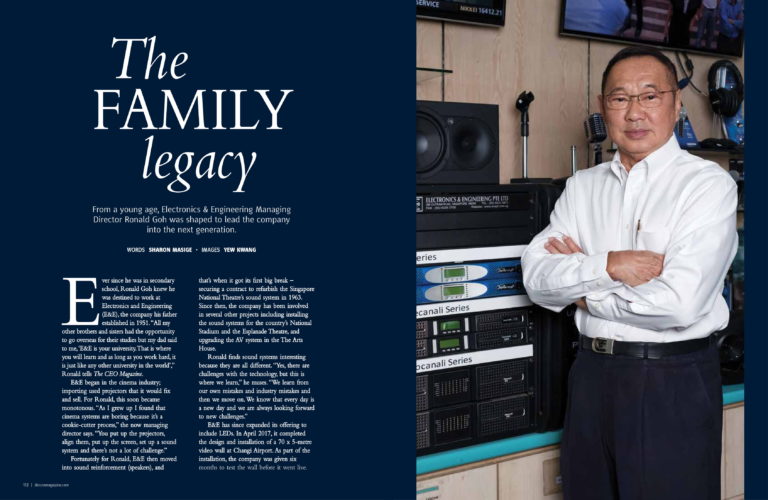The CEO Magazine Asia is a monthly business magazine for CEOs and executives around the world.
The CEO Magazine Asia
Their February edition features how Mr. Ronald Goh, Managing Director of Electronics & Engineering Pte Ltd (E&E) was shaped to lead his company into the next generation.
Ever since he was in secondary school, Ronald Goh knew he was destined to work at Electronics and Engineering (E&E), the company his father established in 1951. “All my other brothers and sisters had the opportunity to go overseas for their studies but my dad said to me, ‘E&E is your university. That is where you will learn and as long as you work hard, it is just like any other university in the world’,” Ronald tells The CEO Magazine.
E&E began in the cinema industry; importing used projectors that it would fix and sell. For Ronald, this soon became monotonous. “As I grew up I found that cinema systems are boring because it’s a cookie-cutter process,” the now managing director says. “You put up projectors, align them, put up the screen, set up a sound system and there’s not a lot of challenge.”
Fortunately for Ronald, E&E then moved into sound reinforcement (speakers), and that’s when it got its first big break – securing a contract to refurbish the Singapore National Theatre’s sound system in 1963. Since then, the company has been involved in several other projects including installing the sound systems for the country’s National Stadium and the Esplanade Theatre, and upgrading the AV system in the The Arts House.
Ronald finds sound systems interesting because they are all different. “Yes, there are challenges with the technology, but this is where we learn,” he muses. “We learn from our own mistakes and industry mistakes and then we move on. We know that every day is a new day and we are always looking forward to new challenges.”
E&E has since expanded its offering to include LEDs. In April 2017, it completed the design and installation of a 70 x 5-metre video wall at Changi Airport. As part of the installation, the company was given six months to test the wall before it went live.
“That is the challenge now. You have to know the problem before it even happens.”
“If a system breaks down at Changi Airport, it has to be working again within the hour or preferably within 15 minutes,” Ronald says. “During the testing period, we applied whatever we thought could happen to the wall – we pulled out cables, switched off the power supply, et cetera – to see what the recovery time was to put the wall back in operation. We went through all kinds of test so that in the future, when such things happen, we know exactly what to do. That is the challenge now. You have to know the problem before it even happens.”
Working in the electronics industry means having to adapt rapidly to changing consumer needs; therefore, the next phrase for E&E is strengthening its software capabilities, “Today’s challenges are not so much on hardware now,” Ronald explains. “The challenges are in the software. Hardware is pretty much standard. It gets improvements and we are ready for those improvements, but it is the software that takes you by leaps and bounds. Software is more powerful. You can do more things in the quickest time possible and there are a variety of configurations at your fingertips.”
E&E’s software is bolstered by partnerships with major software providers such as China’s NovaStar, which installed its first-generations Synchronous Control System on Morgan Plaza’s 3,400-square-metre screen for the 2008 Olympic Games in Beijing. Ronald is willing to learn from companies like NovaStar to help with his company’s success. “Nova-Star has the backing of nine university PhD professors, plus 500 students who have been doing R&D in this technology for the past seven or eight years, working on this operating software and technology. This is why they are so good, and they know they are so far ahead of anybody else in the world,” Ronald says. “They will probably have the monopoly of the market for the next decade.”
Looking ahead, Ronald emphasises the importance of keeping abreast of the latest software and best practice. “This industry is getting to be more and more interesting. It has moved from simple, single speaker systems, to Dolby systems,” he says.
“We finished the largest Dolby Atmos sound system in Singapore’s Grand Theatre, which has 64 speakers and two subwoofers; one in the front and one in the back. The Atmos sound system is what creates a 3D aural experience. If, in a movie, a shot is fired in the middle of the hall, the sound is already in the middle of the hall. This is all about digital steering. With four speakers, we can steer the sound to where it originated. This is the software that we need to learn to keep ourselves updated and to be at the forefront of the industry.”
Publications










